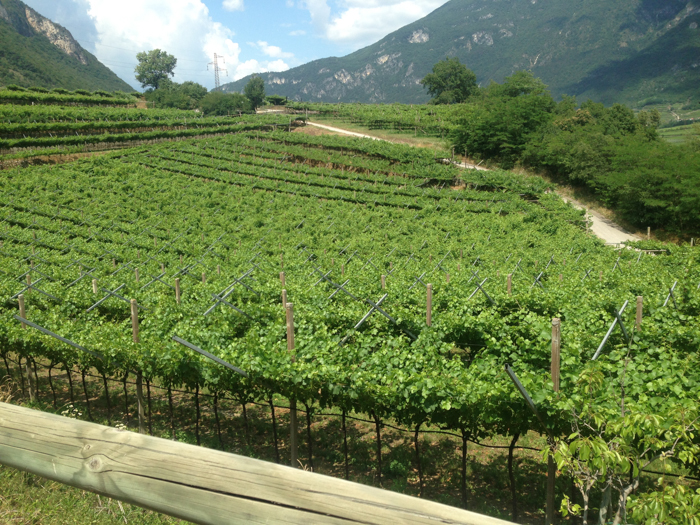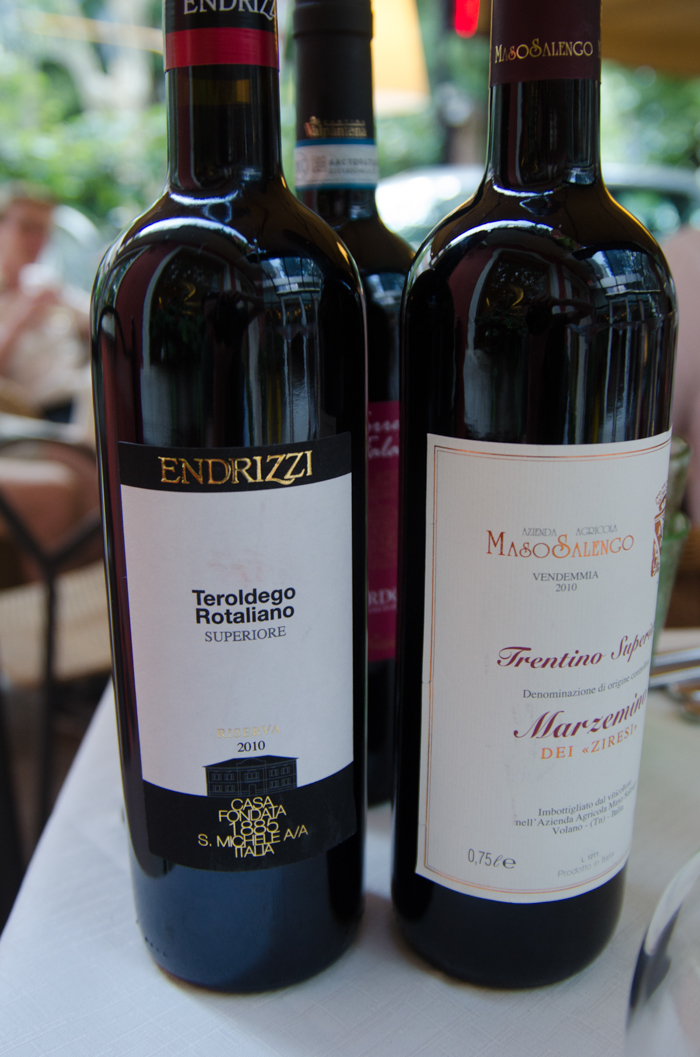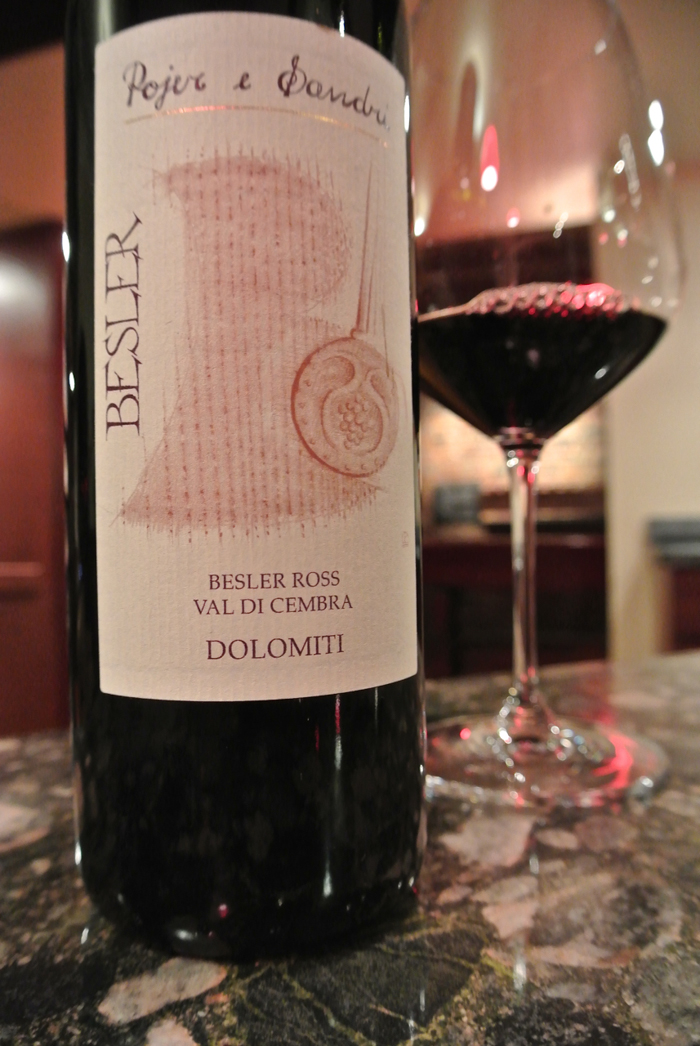The Trentino DOC is located in the south of the Trentino-Alto Adige region of Italy. Most of the vineyards of this region lie along the Adige River Valley that runs from north to south. A large variety of wines are produced here, from Austrian style wines near the border, to more Italian style wines south towards the Veneto. One will also find table wines and a sweet vin santo.

Wine has been produced in this region for over 3000 years. The original settlers to this area, Illyrian people who first arrived in Liguria and traveled east, eventually settling in Trentino, brought the practice of grape cultivation with them from Greece. The Roman writers Strabo, Virgil and Suetonius all praised the wines of this region. In the Middle Ages, the cultivation of the vineyards became the work of the monks, the church being one of the largest landowners of the era.
As early as the 12th century, we see the very first regulations controlling the production of wine, including guidelines on the harvesting of the grapes and restrictions in the Statutes of Trent that limited the import of wines from the surrounding zones. Michelangelo Mariani, historian of the Council of Trent, wrote that the Trentino winemakers of the 16th and 17th centuries “make wines without pretense, as it comes, and without adulteration.”
This DOC is not to be confused with the Trento DOC, as I was when I first began researching these zones. They are often referred to erroneously by the others’ name. The Trento DOC, also located in Trentino, is reserved specifically for the renowned white and rose sparkling wines produced by the traditional Champagne method.
Whites:

Bianco: Chardonnay and/or Pinot Bianco, with a minimum content of 80%; can include up to 20% of Sauvignon, Mueller Thurgau and/or Manzioni Bianco.
Bianco Superiore and Riserva: A minimum of 85% Chardonnay, Pinot Bianco and/or Pinot Grigio; can include up to 15% of Sauvignon, Traminer, Riesling and/or Manzoni Bianco. Aged at least 12 months. The Bianco Riserva must age for 24 months.
Chardonnay: A minimum of 85% Chardonnay, with up to 15% made from similar, non-aromatic varieties. A Superiore must be aged 10 months, a Riserva version for 24 months. Vendemmia Tardiva Chardonnay is a sweet wine, aged for 12 months, as is the Superiore version.
Chardonnay-Pinot Bianco, Chardonnay-Pinot Grigio, Chardonnay-Sauvignon: All dry whites, with 51-75% Chardonnay, the other named varietal makes up the remainder.
Muller-Thurgau: A minimum of 85% Muller-Thurgau, with up to 15% made from similar, non-aromatic varieties. There is also a Superiore version, as well as sweet Vendemmia Tardiva and Vendemmia Tardiva Superiore.
Moscato Giallo: A minimum of 85% Moscato Giallo, with up to 15% made from similar, non-aromatic varieties. There is also a Liquoroso (a sweet, fortified wine), a Superiore version, as well as sweet Vendemmia Tardiva and Vendemmia Tardiva Superiore.
Nosiola: A minimum of 85% Nosiola, with up to 15% made from similar, non-aromatic varieties. There is also a Superiore version, as well as sweet Vendemmia Tardiva and Vendemmia Tardiva Superiore.
Pinot Bianco: A minimum of 85% Pinot Bianco, with up to 15% made from similar, non-aromatic varieties. There is also a Superiore version, a Riserva version, as well as sweet Vendemmia Tardiva and Vendemmia Tardiva Superiore.
Pinot Bianco-Pinot Grigio and Pinot Bianco-Sauvignon: All dry whites, with 51-75% Pinot Bianco, the other named varietal makes up the remainder.
Pinot Grigio: A minimum of 85% Pinot Grigio, with up to 15% made from similar, non-aromatic varieties. There is also a Superiore version, as well as sweet Vendemmia Tardiva and Vendemmia Tardiva Superiore.
Pinot Grigio-Sauvignon: A dry white, with 51-75% Pinot Grigio, with Sauvignon making up the remainder.
Riesling (Renano): A minimum of 85% Riesling, with up to 15% made from similar, non-aromatic varieties. There is also a Superiore version, a Riserva version, as well as sweet Vendemmia Tardiva and Vendemmia Tardiva Superiore.
Riesling (Italico): A minimum of 85% Riesling, with up to 15% made from similar, non-aromatic varieties. There is also a sweet Vendemmia Tardiva.
Sauvignon: A minimum of 85% Sauvignon, with up to 15% made from similar, non-aromatic varieties. There is also a Superiore version and a RIserva, as well as sweet Vendemmia Tardiva and Vendemmia Tardiva Superiore.
Traminer Aromatico: A minimum of 85% Traminer, with up to 15% made from similar, non-aromatic varieties. There is also a Superiore version, as well as sweet Vendemmia Tardiva and Vendemmia Tardiva Superiore.
Vin Santo: Made from a minimum of 85% Nosiala grapes, with the remaining 15% or less of other local non-aromatic white varieties. A sweet white, aged for a minimum of 36 months. The Superiore version must age for at least 53 months.
Rose
Moscato Rosa: A minimum of 85% Moscato Rosa, with up to 15% made from similar, non-aromatic varieties. There is also a Superiore version and a RIserva, as well as sweet Vendemmia Tardiva and Vendemmia Tardiva Superiore.
Rosato or Kretzer: Contains at least two of the following varietals: Enanito, Schiava, Teroldego, and/or Lagrein, up to 70% maximum of any one.
Reds

Cabernet: A blend of Cabernet Sauvignon and Cabernet Franc. Also available as a Superiore and a Riserva.
Cabernet-Lagrein: A dry full-bodied red, with 51-75% Cabernet Sauvignon, with Lagrein making up the remainder.
Cabernet Franc: A minimum of 85% Cabernet Franc, with up to 15% made from similar, non-aromatic varieties. There is also a Superiore version and a RIserva.
Cabernet Sauvignon: A minimum of 85% Cabernet Sauvignon, with up to 15% made from similar, non-aromatic varieties. There is also a Superiore version and a RIserva.
Lagrein: A minimum of 85% Lagrein, with up to 15% made from similar, non-aromatic varieties. There is also a Superiore version and a RIserva, as well as a rose version.
Marzemino: A minimum of 85% Marzemino, with up to 15% made from similar, non-aromatic varieties. There are three Superiore versions, Superiore, Superiore Isera and Superiore Ziresi (all aged a minimum of 10 months) and a RIserva.
Merlot: A minimum of 85% Merlot, with up to 15% made from similar, non-aromatic varieties. There is also a Superiore version and a RIserva.
Merlot-Lagrein: A dry red, with 51-75% Merlot, with Lagrein making up the remainder.
Pinot Nero: A minimum of 85% Pinot Nero, with up to 15% made from similar, non-aromatic varieties. There is also a Superiore version and a RIserva.
Rebo: A minimum of 85% Rebo, with up to 15% made from similar, non-aromatic varieties. There is also a Superiore version.
Rosso: A blend of Cabernet Franc and/or Cabernet Sauvignon and/or Merlot, with up to 100% of any one of the three. A Superiore version can contain a maximum of 85% of any of these three varietals, with either Lagrein and/or Rebo making up the remaining 15%.
In addition to all of the above, there are two blends known as Sorni. Sometimes listed as a separate DOC altogether, the vineyards for these wines are located in the Colline Avisiane north of Lavis.
Sorni Bianco: Nosiala, Muller-Thurgau, Silvaner, Pinot Bianco, Pinot Grigio, and/or Chardonnay; up to 100% of any of these varietals.
Sorni Rosso: Teroldego, Schiava and/or Lagrein; up to 100% of any of these red varietals.


